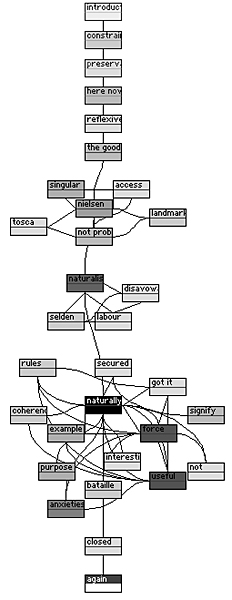
|
Writing on the rhetoric of hypertext, while acknowledging the significance of the link to hypertext, has been unable to recognise the extent to which the link is outside of grammatical and syntactic categories. This invisibility of the force of the link largely results from an economy of writing that privileges clarity and reason. However, the link problematises this through its analogical form which perhaps owes more to images than to language.
Links cannot state the true or the false; they cannot negate, and so they are only ever subject to an ethics of good and better -- or poor and worse. This is why Landow's rhetoric must become a series of rules, of prohibitions and constraints, for it appears that the link aligns itself with the capriciousness of the visual rather than the 'rigour' of the written. This is an old debate, one that has been documented by Barbara Maria Stafford and W.J.T. Mitchell, and Landow, in "Hypertext as Collage-Writing," makes this very move. However, it does appear that this debate may now have new spirit, along terms that are yet to be developed or explored, as the logic of the image has asserted itself within the field of writing. Links have an economy of excess that seem more applicable to the image and its ability to argue than to the forms of logical argument that we associate with writing.
Usability and rhetoric remain fundamental terms and categories in any conception of hypertext writing. However, the effort to develop rules and grammars of hypertext rhetoric represent efforts to recuperate the link within a restricted economy that seeks to ground a potential poetics within the singular and unitary. To the extent that such a practice risks canonisation, hypertext as an active, creative, and riskful process for thought will remain stymied and unavailable. Twelve years after the World Wide Web was invented hypertext is an eccentric exception in academic writing -- critical and creative scholarship needs to be begun.
|